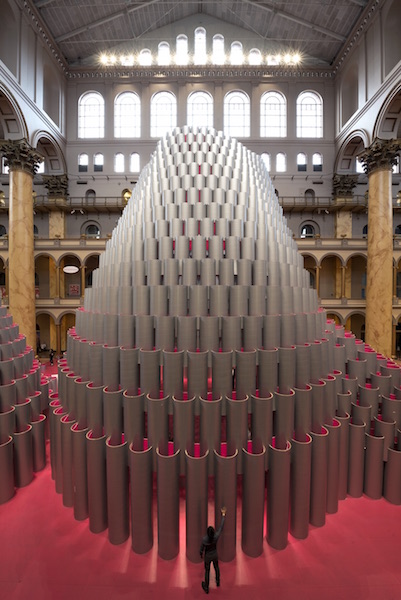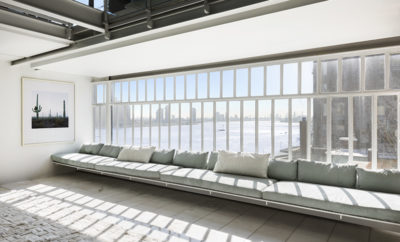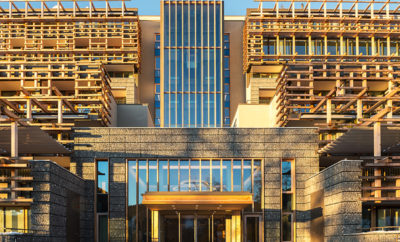 Hive at the National Building Museum. Photo by Tim Schenck
Hive at the National Building Museum. Photo by Tim Schenck
Exhibition
Jeanne Gang’s Hive for Humans Creates a Buzz
Beekeepers refer to the hive as the structure that houses bees and their honeycomb. Historically this has ranged from a clay jar to a straw basket, a hollowed-out log to a painted cupboard, but Jeanne Gang’s Hive is a summer installation constructed inside the National Building Museum’s monumental central hall with approximately 2,700 notched and interlinking wound paper tubes, silver on the outside and glowing magenta within. Stacked into three massive and connected open domes–the tallest almost skirting the building’s fourth-floor catwalk–the catenary form is suggestive of coiled grass skeps that have been used by bee farmers for centuries. The tubes, calibrated in size, ranging from knee-high to ten feet, are reminiscent of the hollow cavities where the bee colony stores honey and pollen, providing cells for workers, drones, and queen.
The museum, Montgomery C. Meigs’s Italian Renaissance Revival masterpiece, was built in Washington D.C. in 1887 as the Pension Office for soldiers who participated in the Civil War and it has served as a site for inaugural balls and presidential celebrations. Since 1985 it has presented hundreds of exhibitions and, during the past four summers, it has opened its doors to cutting edge architects who have designed installations that allow visitors to interact with the grand historic space. Rising between two screens of seventy-five-foot Corinthian columns with acanthus leaves curling like a canopy of trees, Hive takes its conceit from the design brilliance of nature while drawing attention to its architectural host. The wedding cake layers of Hive ingeniously compliment the museum’s palazzo structure with its large open interior and tiers of arcade galleries while the colored tubing provides a striking contrast to the massive columns painted to look like marble and the seventy-six gilded planters situated along the metal railing of the third-floor balcony and decorated with double eagle head handles.

Hive at the National Building Museum. Photo by Tim Schenck
With light pouring through the building’s clerestory windows, Hive—on view through September 4—is stunning to look at and, like much of Jeanne Gang’s work, it is extraordinarily photogenic as well as visually changeable. From the outside, the massed together tubes might seem like the pipes of an organ or tiles of a terra cotta roof. From inside one of the domes (looking up to the oculus), they might seem like the facets of a rose window. While it took five years to build the Pension Office, a structure that exudes the feeling of permanence, Jeanne Gang’s studio spent six months designing the Hive and it was erected in just a bit more than three weeks. The tubes are relatively light (the largest weighing two hundred pounds), biodegradable, and recyclable. The layers notch together like Connectagons or Lincoln Logs, though it took sophisticated mathematics, engineering, and design to build the domes. One of the unintended surprises is that the upper layers tilted in, shifting organically, so you might say it’s truly a breathing and moving structure.
In nature, the beehive produces a mass of vibration that corresponds to a colony’s development and health, the bees’ work, and their intention to swarm. In recordings, the noise of a hive brings to mind the constant sound of wind or water. Jeanne Gang’s Hive registers as chimes, rings, and thumps thanks to the work of John Tewksbury, an acoustic engineer, and Steve Bloom, a percussionist, who developed a sound structure for each of the domes, fitted with paddles and drums and an array of ordinary objects like wrenches for visitors to beat and clang. Combining plumbing and garden piping, they constructed a tubular xylophone that looks something like a periscope but collects the sound hubbub and circulates it around the architectural space. They say frequency of its lowest note, a low bass tone, is 52 Hz, a sound that is associated with the enigmatic lonely whale, another member of the natural community.













